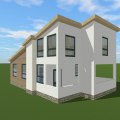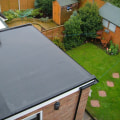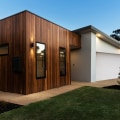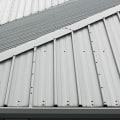Flat roofs are among the most controversial of all types of roofs for buildings and homes. They are most commonly used in outbuildings and large structures, and while they aren't the most glamorous option, they have advantages. Knowing the pros and cons, such as the price of repairing a flat roof, the necessary roofing material, potential water accumulations and roof leaks, will help you make the decision that best suits your building. The biggest advantage of a flat roof is the expense.
From construction and installation to materials commonly used for flat roofs, they are relatively cheap. Flat roof insulation board costs approximately 80 cents per foot, making a flat roof very affordable for both installation and maintenance. Labor is cheaper due to the lower risk when installing a flat roof. Installing flat roofs is faster and easier, resulting in less damage and repair costs over the life of the roof. Installing elements such as solar panels, which save electricity, and satellites, makes repairs and cleaning of gutters less expensive and easier to carry out on flat roofs.
The second advantage is that the space can be used for other purposes. Air conditioning units can be placed on the ceiling instead of on the floor. Flat-roof solar racks installed on a flat roof are less evident from the ground than on a sloped roof. You can design a livable ceiling that becomes an outdoor living area for relaxing or barbecuing, or plant a rooftop garden. The list of possibilities for using a flat roof is almost endless.
A flat roof also makes the interior space more versatile. Top floor apartments and finished attics are possible without the sloped walls produced by traditional sloped ceilings. In homes that need maximum interior space, flat roofs are a significant advantage. Flat roofs are often more accessible than sloped roofs. It's easier to climb on them to inspect them; care and caution must be taken every time a person climbs onto a roof. Flat roofs are easier to check and much safer.
Flat roofs are substantially more stable than sloped roofs when the building is small. In the right environment, they are economical as long as they are properly maintained. Because flat roofs are faster to install, the wait to move is shorter. If repairs or replacements are needed in the future, reroofing is relatively simple and quick. As the areas of a flat roof increase, stability decreases.
Industrial buildings and businesses that have flat roofs have to compensate for the weight inside. Material for flat roofs is a bit scarce; there aren't many options to choose from. Rolled roofs are used in most flat roofs; they are made of bitumen, TPO (thermoplastic polyolefin), EPOM (ethylene propylene diene monomer) or rubber. Each of them is relatively inexpensive and easy to install with a life expectancy between ten and 15 years. There are rubber shingles that can be installed together with rolled rubber roofs. Some new materials are available, such as PVC and polycarbonate roofs; because they are recently developed products, there is no information on how long they will last. Drainage, or rather, the lack of it, is the biggest disadvantage.
Flat roofs don't drain as efficiently as sloped roofs; water tends to accumulate and stay on the roof. Stagnant water can cause roofing material to break or future leaks, especially along the seams. A flat roof contractor is likely to install additional mechanisms to address proper drainage; water disposal options are time consuming and can be costly. Proper sealing of both the top layer and the bottom layer is critical to the integrity of the roof; coating is periodically tested for leaks on flat roofs to ensure that there are no leaks. Flat roofs are normally installed in warm weather; buildings with flat roofs are more affected by extreme temperature changes because there is less space for installation. Most can't bear the weight of snow accumulated in winter. There are flat roof companies that consider problems with insulation and snow weight to be misconceptions; they suggest that flat roofs can be installed in cold climates when the roofs have a substantial thickness that leaves room for sufficient insulation. A thick roof can also withstand snow accumulation as long as it's not due to an avalanche; snow adds to insulation.
The TPO (thermoplastic polyolefin) is an excellent roofing system for warm climates. TPO roofing systems are an example of improvements being explored; seams of TPO ceilings are welded instead of glued together; they are less likely to separate when heated. Manufacturers certify flat roof contractors to install membrane and meet warranty. The TPOs provided a white surface that reflects heat away from building; this helps reduce energy costs during summer months by keeping building cooler inside. Be a smart shopper and weigh your pros and cons when making the decision to get the best value for your money. An experienced and reliable roofing contractor is the best choice for building a durable and functional roof.



